While metal music got some negative coverage in its early days, there’s absolutely no doubt that it made a huge mark on modern music in general. And as it evolved, it began impacting other genres as well, even taking an important place in mainstream waters.
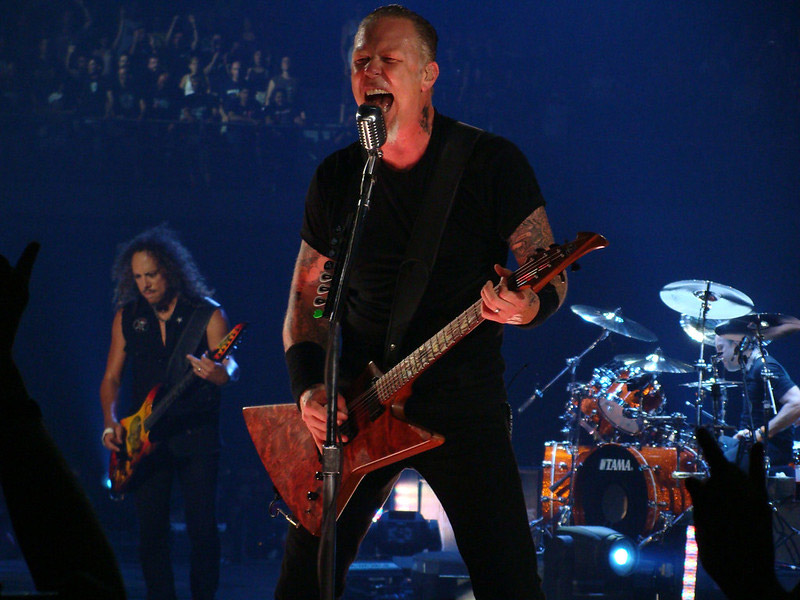
But although it’s widely accepted that the Metal genre started in the late 1960s and the early 1970s with bands like Black Sabbath, Led Zeppelin, and Deep Purple, the 1980s bands innovated the genre in a way that made it their own, and that’s especially the case with Metallica.
What Guitar Does James Hetfield Play?
James Hetfield primarily plays Explorer-style guitars made by Ken Lawrence, Gibson, as well as ESP. James is also known to own and play several V-style guitars as well as Les Pauls. He’s played many others throughout his career.
See the full list of most notable James Hetfield guitars below.
Ken Lawrence Explorer, aka “Carl”
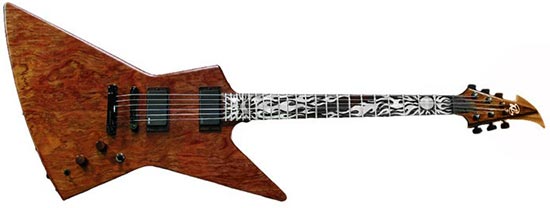
| Finish | Natural with Custom Details |
| Years Used | 2012 to Present |
And we’ll start things off with one rather sentimental instrument built for James by Ken Lawrence. Back in the late 1990s and the early 2010s, Metallica considered actually buying an old garage where they used to rehearse in the early 1980s. Although they found out that the garage was demolished, they got ahold of some old wood that was, for some reason, kept by one of their friends.
Being a very thorough guitar builder, Ken took his time to finish it up. Some pretty nice aesthetic touches on this Explorer were done by Serbian artist Petar Milivojević and they actually tell some stories about Metallica history. The body is accompanied by a mahogany neck and an African Blackwood fretboard. The nickname “Carl” is a reference to Carlson Blvd in El Cerrito, California where their old rehearsal place was located. This is also known as the James Hetfield garage guitar.
1996 Custom Ken Lawrence Explorer
| Finish | Natural |
| Years Used | 1996 to Present |
But Hetfield’s cooperation with Ken goes way back to the mid-1990s. The first instrument he built for him was a pretty-looking explorer with a mahogany body, mahogany neck, and a unique-looking headstock. It was initially fitted with EMG 81 and 60 active humbucker pickups, although he later swapped them with his signature EMG-JH humbuckers.
However, James has at least two of these Explorers. He got the second one in the early 2000s, and this instrument features a Bubinga top, as well as some rather stylish fretboard inlays. You can see him using this second one on a lot of Metallica’s live shows, so it has seen a lot of action over the years. This was during the band’s “Load” and “Reload” era, which was met with somewhat mixed reactions from the fans but saw James utilize different sounds and techniques compared to the group’s full-on thrash metal period of the 1980s. When most people ask what guitar does James Hetfield plays one of his explorer styles guitars, such as this Ken Lawrence model, comes to mind.
Ken Lawrence Custom Flying V
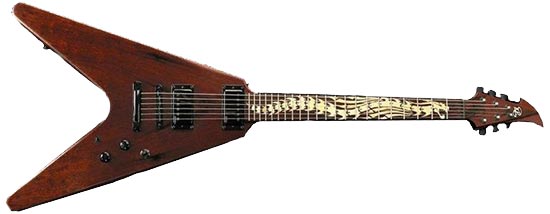
| Finish | Natural |
| Years Used | 2011 to Present |
Another great example of Ken’s impeccable craftsmanship is James’ custom Flying V model. This one bears a pretty much identical headstock design to those on his custom Explorers, while the body is shaped exactly like Gibson’s classic Flying V guitars. We also have a special kind of inlay design, resembling a dragon or a serpent engraving and wrapped around most of the neck’s length. On the other hand, not much is known about this instrument, and Hetfield is not often seen holding it. This fella proves that James still likes to spice things up in terms of gear even this late into his musical career.
Popular Related Article: Kirk Hammett Rig Rundown
1973 Gibson Les Paul Custom
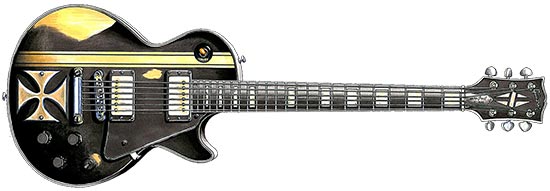
| Finish | Black Worn with Custom Details |
| Years Used | 2002 to Present |
Being a metal musician, it’s only expected of James to have some Gibsons in his collection. One of the most interesting guitars, though, is the 1973 Les Paul Custom. It’s not sure when and where he got it, but the instrument came with Sperzel locking tuners, EMG 81 and 60 pickups, and golden covers. It’s easily recognizable with its Maltese cross behind the bridge and golden stripes on the bass side of the body. This one has been used heavily during the “St. Anger” era. Gibson Les Pauls are generally associated with later Metallica stages as far as Mr. Hetfield is considered.
ESP James Hetfield Iron Cross
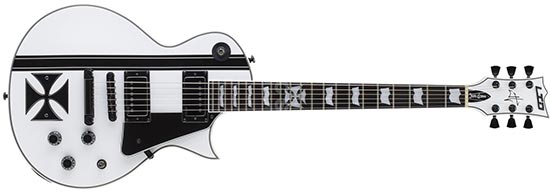
| Finish | White |
| Years Used | 2017 to Present |
Over the years, James became quite fond of ESP guitars. So he got his own special custom-made guitar with them. This ESP model in particular is a James Hetfield signature guitar. The Iron Cross model was inspired by the aforementioned Gibson Les Paul Custom from 1973. Taking a look at the body, it looks pretty similar, though the “Iron Cross” visual is a bit different. Then we have an obviously different fretboard design with ESP’s famous “flag” inlays, as well as a Maltese cross inlay on the 12th fret. The guitar is also loaded with active pickups. ESP and ESP LTD both produce James Hetfield signature models that are made after this instrument. This is one of the more well-known guitars of James’ modern Metallica arsenal.
ESP James Hetfield Snakebyte
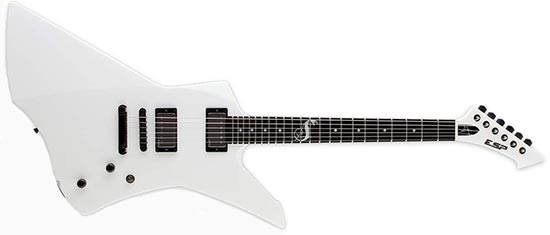
| Finish | White |
| Years Used | 2015 to Present |
The Snakebyte is another James Hetfield signature guitar. Knowing how fond James is of Explorer guitars, it’s not a surprise to see him using a bunch of different variations to this classic body shape. However, he has a few very interesting ESP Snakebyte guitars that were made especially for him. One of them is a plain white model with no special insignia on it. It’s not certain when he began using this particular one, but it’s most likely during the mid-2010s. This is a classic heavy metal-oriented instrument, bearing a mahogany body, mahogany neck, ebony fretboard, and a pair of EMG James Hetfield signature humbuckers. Along with the Ken Lawrence models, this is another explorer style guitar that comes to mind when the question is asked, what guitar does James Hetfield use?
ESP James Hetfield Snakebyte Custom Baritone
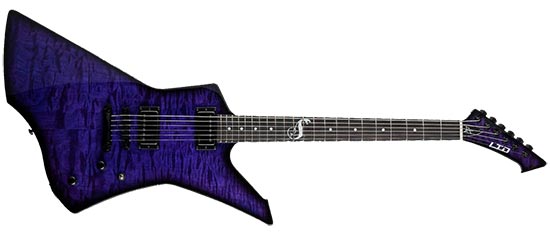
| Finish | Military-style camo, Purple sunburst |
| Years Used | 2015 to Present |
Another of these great James Hetfield ESP Snakebyte guitars. James has two of these baritone models. The first featuring a unique-looking gray camo finish and the second a purple sunburst. Not many details are known about this instrument which he began using for the WorldWired Tour, most notably for “Sad But True.” This one comes with a longer baritone-style scale length, allowing for more stability when using those lower tunings, so you can see James using it for other down-tuned songs as well.
ESP MX220, aka “Eet Fuk”
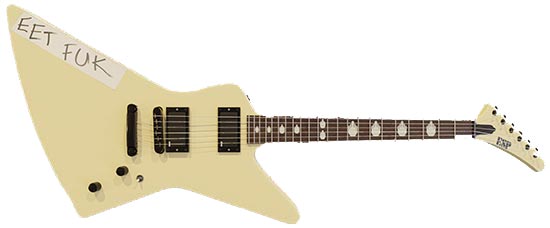
| Finish | White |
| Years Used | 1987 to Present |
One of the most famous instruments in James Hetfield’s collection is the ESP MX220 with a white finish and a rather unusual “EET FUK” caption on it. Getting this white Explorer-shape ESP guitar back in 1987, right before the recording of “…And Justice for All,” the caption was added sometimes in 1988.
Once again, we have a regular combo of a mahogany body and a mahogany set-in neck, as well as a rosewood fretboard with middle finger inlays. It became his go-to guitar during this period. “EET FUK” ESP Explorer also features a pair of EMG humbuckers, 81 and 60 models, which is quite common for James’ guitars. This instrument is associated with Hetfield’s roaring, the crunch-driven sound of the band’s thrash metal peak demonstrated on the “…And Justice for All Tour,” recorded at the iconic 1989 live show in Seattle, WA.
Electra 2236 Flying V
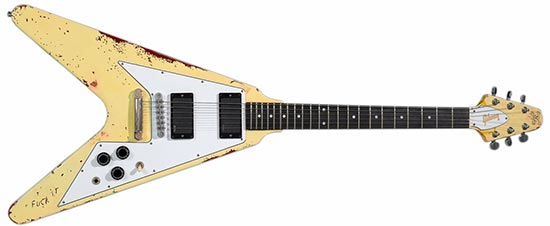
| Finish | White |
| Years Used | 1980 to 1984/2008 to present |
For this instrument, we need to go all the way back to 1980, which is even before Metallica was formed. Back then, James bought a Gibson Flying V copy by Electra, the company’s 2236 model. Reportedly, he paid it $200 back then. Although relatively cheaper alternatives back in the day, these instruments are rare and they became popular among collectors due to James Hetfield.
Hetfield used it on the “Kill ‘Em All” debut album and it stayed his main workhorse until 1984 when he managed to snap its neck during a live show. The instrument was restored to a fully functioning state back in 2008. The instrument used to have Seymour Duncan Invader pickups, but he swapped them for the EMG 81 and 60 set. This guitar is a true deep-cut gem in James’ collection and an item many hardcore fans are fascinated with.
1984 Gibson Explorer, aka “So What”
| Finish | White |
| Years Used | 1984 to Present |
Right after he managed to snap the neck on his precious Electra, James started experimenting with different guitars. Finally, he settled for a 1984 Gibson Explorer that became popular for its “So What” sticker. Back when he got this instrument, it was fitted with Gibson’s 496R and 500T humbuckers.
Later during the 1980s, most likely in 1987, James swapped them for a standard pair of EMG 81 and 60 pickups. The instrument in its original setting saw heavy use on the “Ride the Lightning” record. In 2008, this instrument was completely restored, just like the Electra Flying V.
1984 Gibson Explorer, aka “More Beer”
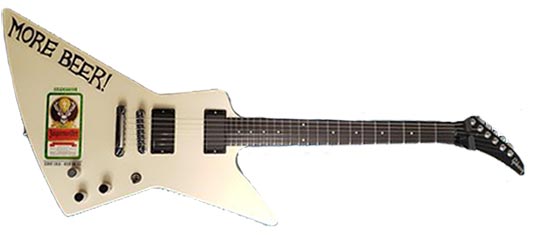
| Finish | White with Custom Stickers |
| Years Used | 1984 to Present |
Another Gibson Explorer from 1984 in James’ collection, the guitar that’s known as “More Beer” was a backup option for his “So What” Gibson. Originally, it was almost identical to the “So What” Explorer, but James added tape over the caption and wrote “More Beer” on it, most likely in 1986.
Later on during the decade, when James signed the deal with ESP, he still used this instrument, although he covered the Gibson logo with a Jagermeister sticker. He also added a Jagermeister sticker behind the bridge. It’s not as popular as the “So What” explorer. Among fans, this model is popularly associated with the band’s “Alocoholica” phase, which ultimately led to rehab stints and a variety of personal issues.
1985 Jackson King V Custom, aka “Kill Bon Jovi”
| Finish | White With Custom Graphic |
| Years Used | 1985 to Present |
Another one from the 1980s, James got into some Jackson guitars back in those days as well. His weapon of choice was their King V that became popular for its addition of a “Kill Bon Jovi” sticker. Although the King V model was popularized by Dave Mustaine, James actually had it before the Megadeth frontman got one of these.
The instrument is fitted with a standard Tune-o-Matic bridge and has Grover tuners, which have always been very typical for Gibson instruments. Originally, the guitar had Seymour Duncan Invaders, but as with a lot of other guitars, James swapped these for EMG’s 81 and 60 humbuckers.
The “Kill Bon Jovi” sticker was reportedly added back in 1987 after Metallica’s Donington Monsters of Rock performance. The story goes that during their show, Jon Bon Jovi hovered over the audience in his helicopter.
Popular Related Article: What Guitar Did Kurt Cobain Play?
1988 ESP MX220, aka “Fuk Em Up”
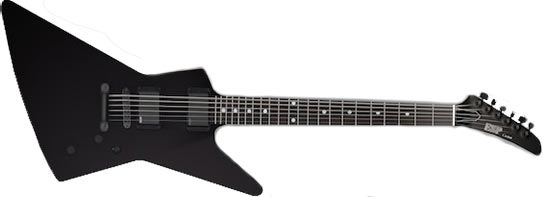
| Finish | Black |
| Years Used | 1988 to Present |
Another awesome ESP MX220 model in James’ vast collection of guitars, he got the so-called “Fuk Em Up” guitar back in 1988, right after the release of the “Justice” album. Although it was originally identical to his other MX220 guitars, James painted it black and added black hardware to it. Of course, we also have a caption on it, with a caption that gave this guitar its popular name. Additionally, we also have an LA Raiders sticker on it.
It’s not uncommon for this instrument to get mistaken for the MX250 model due to its somewhat unusual headstock design. However, MX250s didn’t come out until 1990, so it’s assumed that this was an experimental MX220 guitar made especially for James.
1996 ESP MX250, aka “Elk Skull”
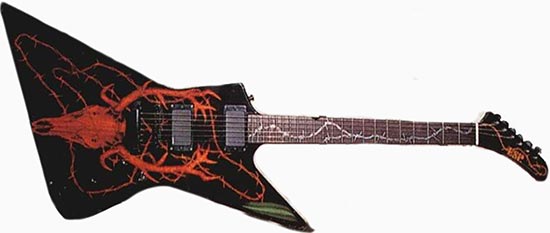
| Finish | Black With Custom Barbed Wired Elk Skull |
| Years Used | 1996 to Present |
Speaking of which, James got ahold of one great ESP MX250 guitar in 1996. The instrument is easily recognizable due to its artwork done by Dino Muradian, representing an elk skull and barbed wire. This instrument’s finish is one of the most famous examples of the pyrography technique.
The barbed wire artwork is also present on the fretboard where it “continues” in form of an inlay, done by artist Rob Thorn. It’s not certain whether James used it on any album, but it found its way onto many of the band’s live shows. It’s a classic metal-oriented instrument with two active EMG humbuckers and standard controls. This one is another instrument connected with the group’s alternative rock-driven phase of the ‘90s, as demonstrated on 1996’s “Load” and 1997’s “Reload” albums.
Double-Neck ESP M250
| Finish | Black |
| Years Used | 1991 to Present |
James Hetfield’s long-lasting friendship with ESP also gave birth to a rather unusual but very attractive and potent double-neck version of the M250 model. Looking at its specs, it’s pretty similar to his other ESP guitars with its hardware and pickups (the standard EMG 81+60 combo). The double-neck design came in handy for “Fade to Black,” since this is a song where it found the most use for the band’s live shows. The instrument’s upper neck is a 12-string one, as you often see with these kinds of instruments. This is one of the rarer guitar models of the Hetfield connections.
Gibson Explorer Korina
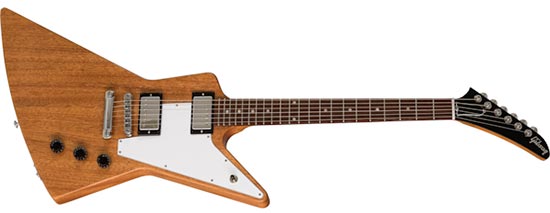
| Finish | Natural |
| Years Used | 2017 to Present |
It’s always thrilling to see an old vintage model in any metal guitarist’s collection. Although we’re not certain when James got his hands on one of these, he began using an old Gibson Explorer from the late 1950s. These instruments are well-known for featuring bodies made out of Korina wood.
Similar to the “Holy Grail” Les Paul guitars from 1959, these are some of the most valued guitars of all time. The official data about original production has been lost, but it is known that no more than 50 of these guitars were made. Some estimates are that only 38 were made, making it one of the rarest models. James expressed fondness with the iconic Gibson Les Paul six-strings in the later stages of the band’s career, hence the years of use should come as no surprise.
1969 Gibson SG Standard
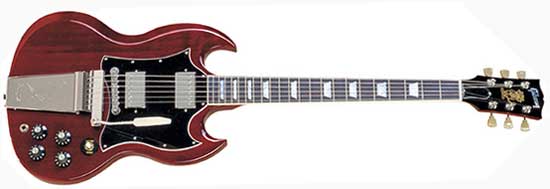
| Finish | Cherry Red |
| Years Used | 1978 to 1989 |
Now we go all the way back to James Hetfield’s earliest guitar-playing days. According to his own words, he got a Gibson SG Standard with a tremolo bridge from one of his high school friends who were in a jazz orchestra at the time. This is most likely a 1969 SG, featuring a classic Bigsby-style tremolo, cherry red finish, and a black pickguard. After using it for a while, he traded this fine SG for a PA system.
This instrument’s whereabouts are currently unknown. Some sources claim that this was a Gibson copy and not the original one. At this point, it’s almost impossible to know the real story. It is not common to see Papa Het sporting a red guitar, which is one of the trademarks of this model as far as Metallica is considered.
Gibson Chet Atkins Signature Classical
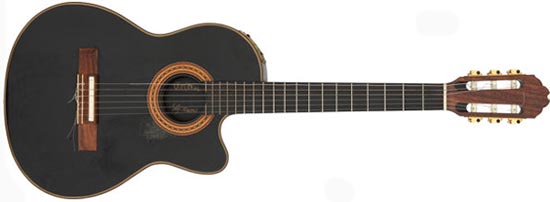
| Finish | Black |
| Years Used | 1988 to 1999 |
While Metallica was criticized by plenty of metal elitists for including acoustic parts in their songs and for writing ballads, they kept doing their thing both in the studio and live shows. For one brief period, James had Gibson’s Chet Atkins signature nylon-string guitar. You can see him using this one on “Live Shit: Binge & Purge” from 1993. More precisely, it was for the performance of “The Unforgiven.” This one is a bit of a deep cut and something only the hardcore crowd knows.
1966 Martin D-28
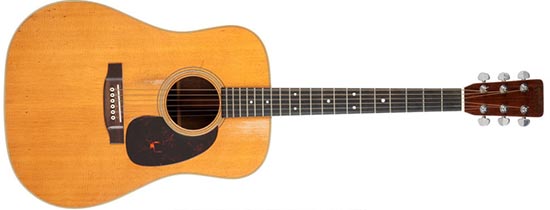
| Finish | Natural |
| Years Used | 1994 to 1997 |
While it’s not certain whether James still has this same exact piece in his collection, he was seen using an old Martin D-28 back in the 1990s. The story goes that this instrument found its way onto the “Load” album for “Mama Said.” He also performed the song live on a few occasions using this same exact instrument. Even to this day, D-28 still remains one of Martin’s most prestigious models.
Plenty of other guitar greats used it over the years, including Bob Dylan, Johnny Cash, and Neil Young among others. It comes with a Sitka spruce top and East Indian rosewood back and sides, a combination that brings a fairly balanced tone. This is a gorgeous instrument sought out by guitar aficionados well beyond the heavy metal genre.
Table Showing the Guitars James Hetfield Used at Each Point in His Career
| Make | Model | Color/Finish | Years |
|---|---|---|---|
| Ken Lawrence | Custom Explorer, aka "Carl" | Natural with custom details | 2010s to Present |
| Ken Lawrence | 1996 Custom Explorer | Natural | 1996-Present |
| Ken Lawrence | Custom Flying V | Natural | 2010-Present |
| Gibson | 1973 Les Paul Custom | Black with custom details | Early 2000s-Present |
| ESP | Iron Cross | White | Late 2010s-Present |
| ESP | Snakebyte | White | Mid 2010s-Present |
| ESP | Snakebyte Custom Baritone | Purple sunburst, Military-style camo, | Mid-2010s-Present |
| ESP | MX220, aka "Eet Fuk" | White | 1987-Present |
| Electra | Flying V 2236 | White | 1980-1984, 2008-Present |
| Gibson | 1984 Explorer, aka "So What" | White | 1984-Present |
| Gibson | 1984 Explorer, aka "More Beer" | White | 1984-Present |
| Jackson | 1985 King V Custom, aka "Kill Bon Jovi" | White | 1985-Present |
| ESP | 1988 MX220, aka "Fuk Em Up" | Black | 1988-Present |
| ESP | 1996 MX250, aka "Elk Skull" | Black with custom details | 1996-Present |
| ESP | Double-Neck M250 | Black | Early 1990s-Present |
| Gibson | Explorer Korina | Natural | 2017-Present |
| Gibson | 1969 SG Standard | Red | Late 1970s/Early 1980s |
| Gibson | Chet Atkins Signature Classical | Black | Late 1980s/Early 1990s |
| Martin | 1966 D-28 | Natural | Mid-1990s |
List of Amps and Other James Hetfield Gear
Marshall JMP, Most Likely the JMP 2203 Model
Years Used: 1982 to 1988
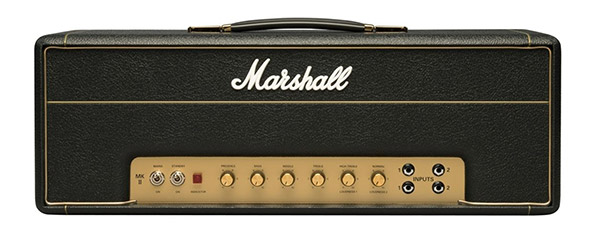
Now going over to James Hetfield’s guitar amps, we’ll first look into the old stuff that he used in Metallica’s earliest days. For the recording of “Kill ‘Em All,” as well as the band’s early career shows, James had a Marshall JMP amp head, most likely the JMP 2203 model. It was one of the go-to models among hard rock and metal guitarists, especially during the 1970s and the 1980s. It featured just one channel and basic controls. Some speculate that this amp could have been 1959 Super Lead, although we cannot know for sure until James confirms it himself. Unfortunately, the amplifier got stolen right before Metallica was supposed to go into the studio to record the “Ride the Lightning” album.
Marshall JCM800 2203
Years Used: 1984 to 1991
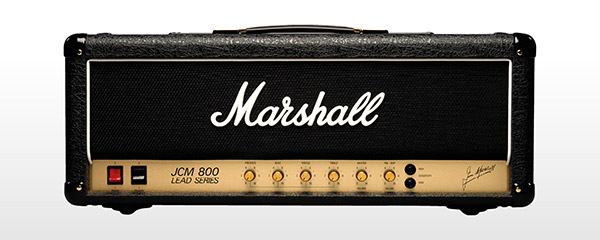
Right after the infamous theft of his old Marshall, James got ahold of a brand new JCM800 2203 for the recording of the “Ride the Lightning” album. Along with this amp head came a Marshall speaker cabinet equipped with Celestion G12-65 12-inch speakers.
For a brief period in the mid-1980s, this was James’ main amplifier. The JCM800 model became pretty popular among metal musicians. Although a single-channel amp that basically has a “dirtier” clean tone, combining it with an overdrive like Ibanez’s Tube Screamer TS9 gave some surprisingly heavy results. Another famous practice was to pair it with the legendary ProCo Rat distortion pedal, which is exactly what James did back then. But we’ll get to that soon. This Marshall JCM800 was later modded by Ken Fischer.
Mesa Boogie Mark IIC+
Years Used: 1984 to 1988
Now, this is where things took a completely different turn for Metallica. You don’t often see a single piece of gear changing the game for one band’s career, but the pretty tight tone of Mesa Boogie’s Mark IIC+ was so powerful that it helped them create one of the albums that eventually ended up in The Library of Congress. Working with producer Flemming Rasmussen, they took time to tweak the tone and perfect it, which is what we can hear on the “Master of Puppets” album. Of course, the band kept using it on the “Justice” album, although the resulting tone was different, mostly due to the final mix of the record.
This particular model served as a blueprint for some of Mesa Boogie’s most advanced amps. Aside from having two channels, the amp also had an additional 5-band graphic equalizer for more detailed tone shaping. It was one of the most diverse amps of the era, although it eventually became really popular among lovers of heavy and tight tones. Many sound aficionados have branded this device as one of the key components for everyone looking to achieve the crushing Metallica guitar tone of the 1980s thrash metal era.
Mesa Boogie Mark V
Years Used: 2010s to Present
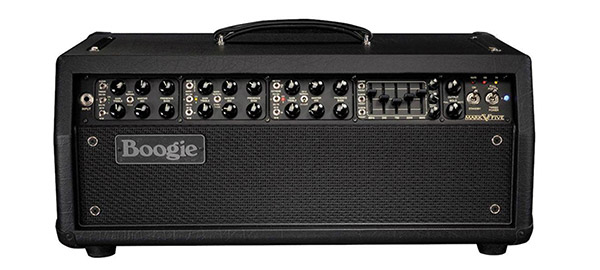
It’s needless to say that James, as well as the other guys in the band, fell in love with the Mesa Boogie IIC+ tone. In more recent years, James was also seen using a Mark V model, which was inspired by the old IIC+ amp. This is a more advanced version of this old model, featuring some quite detailed tone-shaping controls. It comes with three channels, as well as the option to “soak up” its output power to lower levels. Each of the channels has very useful controls that even let you add more brightness or tightness to it. What’s more, the amp is also equipped with the now-famous switchable 5-band equalizer. But the most impressive part is that each of the channels has a switch for three different voicings, which opens up a whole new world of possibilities.
Mesa Boogie Triple Rectifier
Years Used: 2010s
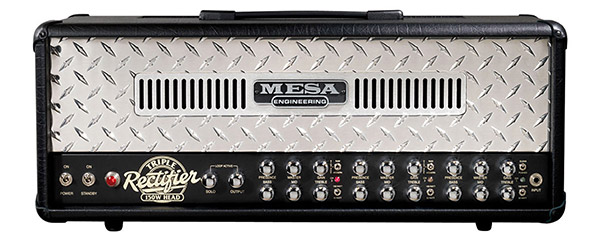
Another one of Mesa Boogie amps in James’ collection, the company’s legendary Triple Rectifier found its use for Metallica’s live shows during the 2010s. This comes as one of the longest-lasting amplifier models of all time, with a few generations of guitar players using its potential. At this point, these are 3-channel amps with a lot of versatility in tone-shaping options.
Once again, each channel is equipped with additional voicing switches, allowing you to add vintage or modern-oriented twists to its tone. Mesa Boogie is a company that leaves nothing untouched and even the effects loop comes with additional controls that let you add a simple boost for lead parts. It’s still one of their most popular products. It is also a proof of Papa Het’s dedication and fondness of the Mesa Boogie products.
Popular Related Article: Tom Morello Guitars and Gear List
Diezel VH4
Years Used: 2002 to Present
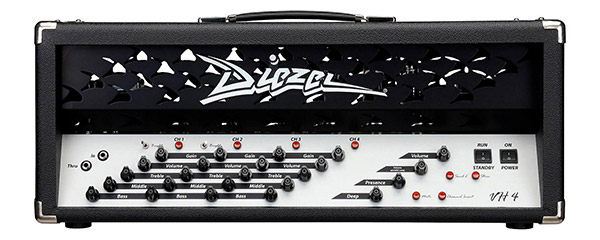
Diezel is probably one of the most underrated guitar amp brands out there. James began using the company’s VH4 amp head around the time the band began recording the infamous “St. Anger” album. This is one of Diezel’s most popular models, known for its heavy and “thick” tone.
This is an all-tube guitar amp, featuring a total output power of 100 watts. What’s rather interesting is that it features 4 channels and it’s capable of all shades of heaviness. It even has 4 effects loops, one for each channel, which opens up a lot of tone-shaping possibilities. Plenty of guitar greats use the VH4 head, including Matt Bellamy of Muse, Adam Jones of Tool, and even Neal Schon of Journey.
Roland JC-120 Jazz Chorus
Years Used: 1988 to present
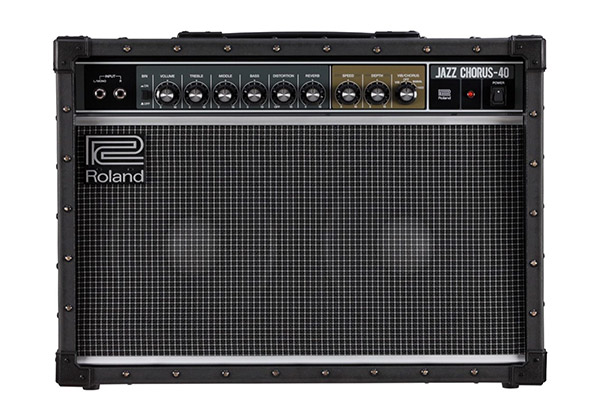
Back when Metallica began recording the “…And Justice for All” album, James truly got into the crystal clear and controlled tone of Roland’s JC-120 Jazz Chorus amp. Although you’d expect a metal guitarist to use something heavier, these proved to be pretty useful for clean sections. Therefore, starting with the “Justice” album, all of James’ clean sections are played through Roland’s legendry Jazz Chorus amp.
The amp was introduced back in the 1970s and its circuitry remains almost unchanged even to this day. This is a solid-state amp that comes with two channels, although it’s better-known for the clean one. Both channels come with two inputs and an additional “bright” switch that adds some high-ends into the mix. It’s also very well-known for its chorus and vibrato effects circuitry, providing a very “spacious”-sounding effect. It’s also fitted with two very powerful 12-inch speakers that can work in stereo mode. The amp’s total power is 120 watts.
Roland JC-120H Jazz Chorus
Years Used: 1988 to Present
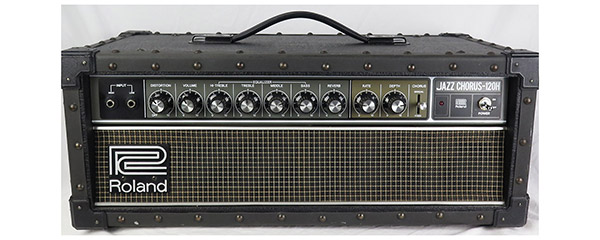
Aside from the standard Roland’s Jazz Chorus combo amp, James also has a JC-120H model in his collection, which is an amp head. These aren’t that common as most guitar players are used to the classic version. It’s pretty much the same amp with a few differences. However, it’s not known when James exactly used it and whether it has seen some action for studio sessions or live shows.
Wizard Modern Classic
Years Used: 1990s to Present
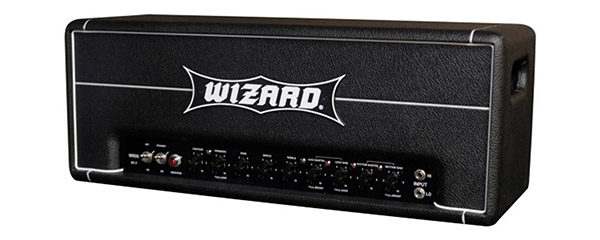
Going to the late 1990s, Metallica recorded a very powerful, and thus popular, covers album “Garage Inc.” which saw them doing songs by Black Sabbath, Thin Lizzy, Bob Seger, Diamond Head, and others. The gear used for this album tends to be a James Hetfield rig fans are curious to learn more about. For this record, James used the Wizard Modern Classic amp head. This is one of the most prestigious amps on the market and it’s made through special orders. Although known for its immense and heavy tone, Wizard’s Modern Classic head is also capable of doing some pretty versatile stuff. It’s also packed with some pretty useful and clever controls, including push and pull knobs for more functionality. Aside from the “Garage Inc.” album, James also used this Wizard amp on “St. Anger” in the early 2000s.
Mesa Boogie TriAxis Preamp
Years Used: 2010s

Knowing how Mesa Boogie amps helped Metallica get some of their best tones, it’s not a surprise to see yet another of their great pieces in James’ collection. However, this time around, we’re looking at a preamp, Mesa Boogie TriAxis. According to the amp manufacturer’s official records, it’s been a part of James’ live setup during the early 2010s.
This is a fully programmable unit that can be combined with any standalone power amp, a power amp section of a regular guitar amplifier, and it can even go directly into a mixing board. It’s equipped with five 12AX7 tubes and it comes with a lot of tone-shaping options. In fact, it can very successfully imitate the tones of different Mesa Boogie amps.
Fractal Audio Axe-FX III
Years Used: 2016 to Present

Now here comes a somewhat “controversial” part. Digital modeling amps have been a part of many discussions among guitar players. However, Fractal Audio’s Axe-FX III has definitely served James, Kirk Hammett, and Rob well as they’ve been using them for live shows for some time now. The practicality of these units is without competition, as they allow very realistic guitar amp tones and a whole bunch of effects, without any need to use entire complex rigs. What’s more, they’re way more consistent as they don’t have tubes that can wear out after heavy use. Metallica has always been up to date with all new trends in the world of guitar gear, so this comes as no surprise.
Fractal Audio Axe-FX II
Years Used: 2010s

Before they got into Fractal Audio’s Axe-FX III, James and Kirk also used the previous version, Axe-FX II. They had this for a while in their live setup, as was revealed with the official rig rundown on the band’s YouTube channel. However, it’s not certain when they began using Axe-FX II units.
Krank Krankenstein
Years Used: 2007
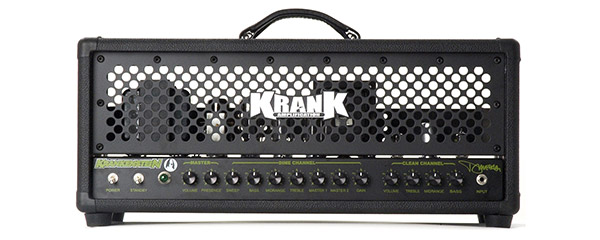
Right around the time Metallica was gearing up to record the “Death Magnetic” album, James began experimenting with Krank’s Krankenstein amp. Eventually, he ended up using it on the record.
Krankenstein is a 100-watt amp head with a fully tube-driven circuit and two channels. In the preamp section, we have the standard 12AX7s, while the power amp section is loaded with Sovtek’s 5881 tubes. This combo brings some pretty heavy, thick, and powerful tones.
Popular Related Article: Billie Joe Armstrong Guitars and Gear List
Krank Revolution 1
Years Used: 2018 to Present
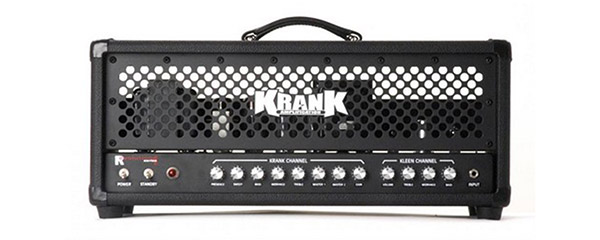
While we’re at it, James had another Krank amp, the Revolution 1 model, back when Metallica recorded the “Death Magnetic” album. Once again, we have a rather heavy amp. Featuring 100 watts of power, this one also comes with 5881 power amp tubes, 12AX7 preamp tubes, and two channels. In many ways, Krankenstein and Revolution 1 amps have a similar tone.
Pedals Used by James Hetfield
ProCo Rat
Years Used: 1983 to Unspecified
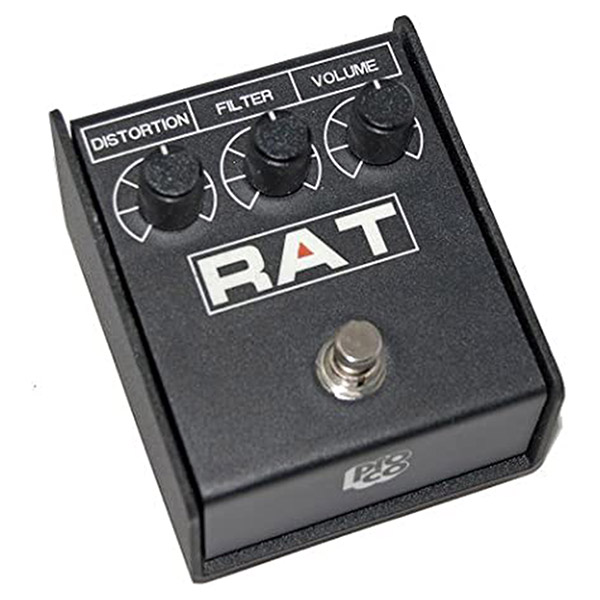
Going back to Metallica’s earliest days, James had a classic ProCo Rat pedal as his main distortion. Combining it with his old Marshall amp head that got stolen, he had a pretty wicked tone, the kind that was typical for the 1980s thrash metal bands. This combo was responsible for James’ tone on Metallica’s “Kill ‘Em All” record. The story goes that it got stolen along with his Marshall amp.
This is a classic distortion pedal with some “fuzzy” overtones. It became a standard during the 1980s and pretty much changed the game in metal music. It features only three simple controls for volume, distortion level, and filter. The filter control is pretty interesting as it helps you roll off high-ends but in a different manner compared to the regular tone knob.
Ibanez TS9 Tube Screamer
Years Used: 1983 to 1992
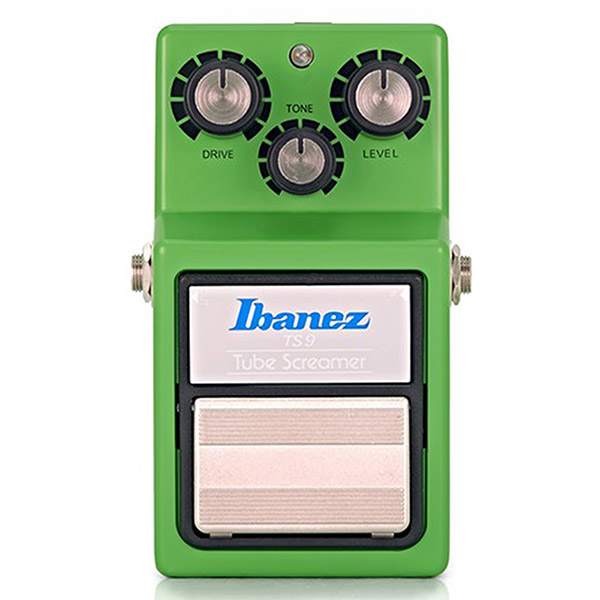
For the “Ride the Lightning” album, James used the Ibanez Tube Screamer TS9 overdrive pedal in combination with the Marshall JCM800 amp. Reportedly, this is the only album where he used this classic device.
Although a smooth-sounding overdrive, when you combine the TS9 pedal with Marshall’s JCM800 amp, you can get a pretty heavy tone with pronounced mids. When you drive its all-tube circuitry over the edge, it distorts pretty nicely and the Tube Screamer pedal truly adds its special twist to it.
Klon Centaur
Years Used: 2012 to Present
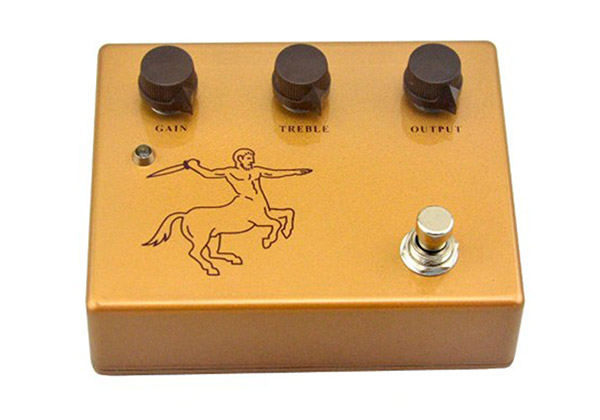
Here we have the mythical beast going by the name of Klon Centaur. These were designed by Bill Finnegan and manufactured between 1994 and 2008. There are about only 8000 of these in circulation and they can reach some head-spinning prices among collectors. Klon Centaur is well-known for adding the distortion without altering the original signal too much. With its IC MAX1044 converter, it raises the voltage up to 18 volts and feeds it to the operational amplifier, which results in a very harmonically rich tone. The pedal can also act as a clean booster with the right setting. James has one of these in his collection, as revealed by his tech in the early 2010s.
Many tried to copy this pedal’s tone. However, this gets pretty hard since all of Klon Centaurs have their circuitries covered in epoxy resin. The pedal still remains highly valued among players of many different genres.
Line 6 DL4 Delay Modeler
Years Used: 2002 to Present
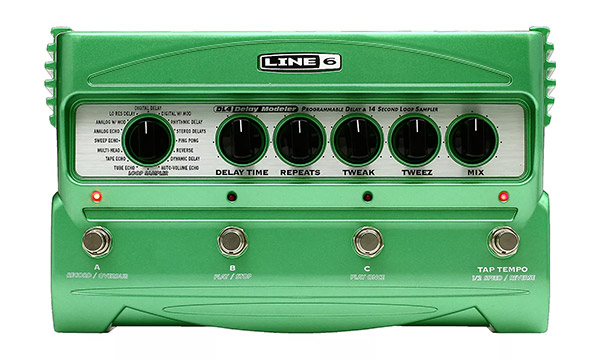
Although it’s not certain when James got ahold of one of these, it’s been confirmed that he has Line 6’s DL4 Delay Modeler in his collection. Unlike most of the delay pedals on the market, this one is a bit more complex and allows for some advanced echo presets.
It comes with a total of 16 delay models, covering anything from those old school tape delays (like the Echoplex) and up to modern digital devices. It can also work as a stereo device and it even comes with an expression pedal input to tweak different parameters depending on the set mode.
Line 6 DM4 Distortion Modeler
Years Used: 2002 to Present
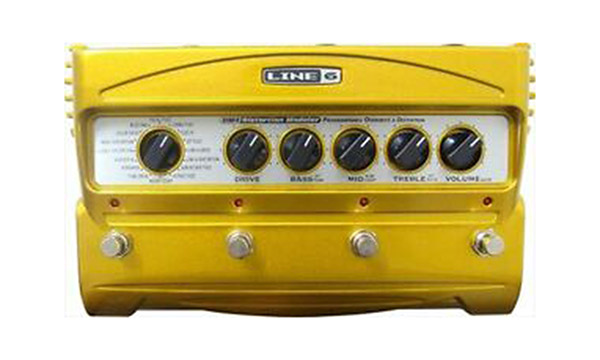
Some reports from the early 2010s show that Hetfield’s been using Line 6’s DM4 Distortion Modeler as a part of his live rig. However, it’s not certain for which songs he has used it or whether he still has it in his collection.
Packed in the same kind of casing as the aforementioned Line 6 Delay Modeler, the DM4 pedal brings some versatile distortion-shaping features. It comes with 16 distortion models, spanning from smooth and up to extreme clipping types.
MXR M107 Phase 100
Years Used: 2010s
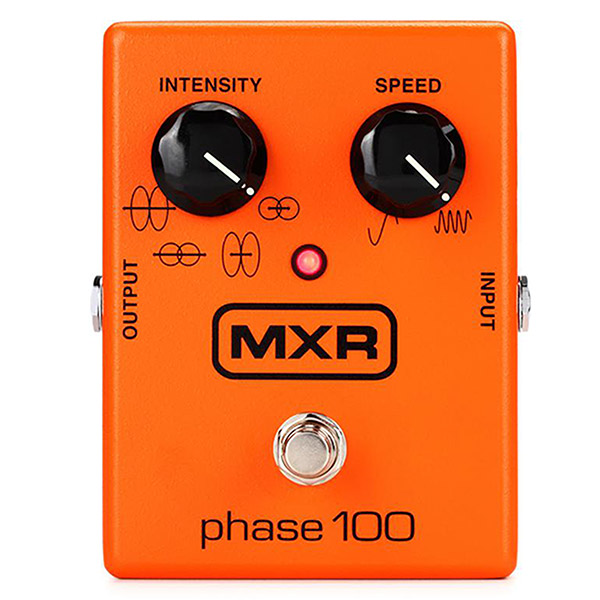
MXR is famous for its phaser pedals, especially the classic Phase 90. However, James has, or had, a slightly more advanced version, the M107 Phase 100 model. It’s been confirmed sometime in the early 2010s that he had it in his live rig, along with Line 6 DM4, although it’s not certain whether he still uses it.
Wrap up
Metallica was formed in the early 1980s by young and ambitious Lars Ulrich and James Hetfield. Although living in the United States, they were mostly inspired by European bands. Giving new life to metal music, Metallica combined the music of two different worlds, and along with some other American bands, laid foundations for what was labeled as “thrash metal” by the music press and big record labels.
However, what made quite a huge impact on metal music were the band’s heavy, tight, and fast riffs played by James Hetfield and Kirk Hammett. And it was especially Hetfield’s riffs that changed the game, especially with his pretty tight downstroke picking technique and very clever use of palm muting. Even to this day, he’s praised for his style of playing and not everyone can copy his exact style. Although some would dismiss metal music for just aggressive high-gain electric guitar noise, we can hear a lot of nuances in Hetfield’s playing, especially in terms of dynamics and how he’s accentuating some notes, all while sticking to his downstroke picking, as well as the alternation between palm muting and open-hand positioning.
But none of Hetfield’s writing and playing practices wouldn’t be what they are without his unique tone that evolved over the years.
And that’s a wrap! We hope that this article was fun and that you’ve learned something new today when it comes to the gear and guitars James Hetfield used and is still using, in the almighty Metallica. As you can see, the frontman has utilized a variety of gear, including some of his staple marks, as well as some deep cuts.

My name is Chris and I’ve had a passion for music and guitars for as long as I can remember. I started this website with some of my friends who are musicians, music teachers, gear heads, and music enthusiasts so we could provide high-quality guitar and music-related content.
I’ve been playing guitar since I was 13 years old and am an avid collector. Amps, pedals, guitars, bass, drums, microphones, studio, and recording gear, I love it all.
I was born and raised in Western Pennsylvania. My background is in Electrical Engineering, earning a Bachelor’s degree from Youngstown State University. With my engineering experience, I’ve developed as a designer of guitar amplifiers and effects. A true passion of mine, I’ve designed, built, and repaired a wide range of guitar amps and electronics. Here at the Guitar Lobby, our aim is to share our passion for Music and gear with the rest of the music community.

I never realized how far back James and Ken Lawrence go. I always associate him with Gibson and ESP which apparently both make a version of his Iron Cross guitar?
The original Iron Cross guitar is a 1973 Gibson Les Paul Custom that was modified/customized. At least the cross and stripes across the top are nonfactory features. As of July 2022 when I’m writing this reply, Gibson has never issued a signature model of the Iron Cross Les Paul. When he began his collaborations with ESP, they conceived and released the first actual signature verison inspired by the original guitar that was available to consumers.
At this point in his career I think his non Gibson guitars have become more synonymous with Papa Het’s playing then even the iron cross, V or explorers. Ken Lawrence and ESP. Ofcourse it would be cool to see some James Hetfield signature Gibson guitars but it would also be cool if Gibson would make quality instruments at a fair price… Anything they would hypothetically make would likely cost 6-8k minimum. What working musician can afford that kind of money for a guitar? Gibson Custom shop might as well just come out an say it that they make collectibles for doctors and lawyers only. Even Gibson USA is way out of control. Will charge you 3k for a guitar with QC issues.